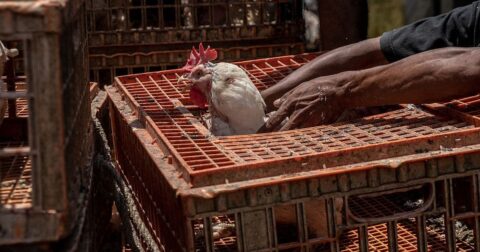Explainer
Are Organized Animal Rebellions Really a Thing?
Animal Behavior•6 min read
Reported
The "sick bird markets" of Indonesia hold answers for our future with bird flu, a growing body of research suggests.


Words by Francesco deAugustinis
With more and more news stories cropping up about new strains of avian flu, it’s difficult to know exactly how worried to be. Will avian influenza cause the next global pandemic? It’s possible. Scientists suspect highly pathogenic avian influenza may already be endemic in the Americas and Europe, meaning the virus persists throughout the year among farmed and wild animals and the environment. Unfortunately, this means avian flu will now have even more opportunities for mutations — and with that an increasing risk to biodiversity, and of setting off a whole new pandemic.
“As a researcher, but also as a citizen, I feel like to some degree in North America the magnitude of the impact is not well understood yet,” Johanna Harvey, a postdoctoral researcher at University of Maryland, tells Sentient Media. Harvey is the lead author of a study published in late April, which analyzes how the evolution of avian flu (a descendant of H5N1, first found in 1996 in a goose farm in Guangdong, China) has changed in very recent years. The study suggests that the disease “will likely become endemic.”

“The data reveals a shift from a seasonal to a year-round disease,” the researchers write. “Previous outbreaks of avian influenza — whether low-pathogenic virus that is endemic in the U.S. or highly pathogenic H5N8 in 2015 — typically occurred in the fall, which meant farmers could prepare for seasonal outbreaks, cull flocks to halt the spread of disease and have nearly a full year to recover losses. But this new virus appears sustained throughout the year.”
Harvey defines this transformation as a “dramatic shift” that occurred in 2020 in Europe, and is now happening in North and South America: “There is no way that [avian flu] is not endemic in the Americas, because it is in too many species, it is too widespread,” she says. “There are many wildlife reservoirs that include waterfall species, ducks, geese, shore birds — and occasionally it moves into poultry with combination through reassortments of the virus.”
In Europe, the latest report of the European Food Safety Authority confirms the continuous circulation of the virus – even in spring, both in farmed animals and in wild birds, especially black-headed gulls. Despite this expected scenario, in early May, a reduction of outbreaks in France — the country most affected by the epidemic in the last two years — convinced the French Ministry of Agriculture to lower the level of risk enough to restore poultry production. A month later, the Ministry itself reported a resurgence of the virus, with 75 new outbreaks in poultry farms in the Southwest regions.
What are the risks if bird flu becomes an endemic disease? A first answer can be found on the other side of the Pacific Ocean, in Indonesia, where several strains of highly pathogenic influenza have been circulating for two decades, since the first global outbreak of H5N1 happened in 2003.
“Since 2003, the highly pathogenic avian influenza has been endemic in Indonesia,” Hank Hogeveen, professor at the Business Economics group of the Wageningen University, Netherlands, tells Sentient Media. In 2019, Hoogeveen published a study about possible measures to fight the spread of avian flu in Indonesia: “Smaller farms suffer from one or more outbreaks per year,” reads the summary of the research. “Sometimes more than half of the chickens die. People also regularly become infected and sometimes die from the effects of avian flu.”
According to Hoogeveen, the causes of this situation are economic and social: “We saw especially in Western Java, which is the most intense poultry area and also one of the most densely populated area of the country, a peculiar situation… something that I’d call ‘sick birds markets.’”

The researcher describes how, although formally not allowed, in Indonesia there is a trade in sick birds: “As soon as they have their flock of chickens and notice that a disease is going around,” he says, farmers slaughter the birds and sell them in wet markets as fresh products. According to Hoogeveen, this system “saves some money [for] farmers,” but “a very bold side effect of course is transmission: sick birds are transported, so transmission of the disease is a disaster.”
The endemism of the disease leads to “a food safety issue” in a country that already imports a lot of meat. It also carries risks to human health: “There is always the risk of an influenza variant popping up that claims much larger numbers of human victims.”
According to a study published in 2019 by researchers from the Indonesian Gadjah Mada University, in the early years of the epidemic the number of human deaths in Indonesia from H591 grew to 150 by 2011, with 46 percent of those infected reporting direct contact with infected poultry.
The situation improved in the following years: “Although to date the virus demonstrated inefficient person-to-person transmission, ongoing outbreaks in poultry pose warning to possibly establish human reassortant avian influenza virus,” reads the study. The researchers send a clear warning: “A genetic rearrangement between influenza viruses of avian origin and influenza viruses from mammals has the potential to emerge new pandemic influenza virus strains in humans.”
From October 2021 to the end of May 2023, 25 different mammals species were infected in 14 countries in North America, South America and Europe. Mammals infected included foxes, sea lions, dolphins, bears, pumas, cats, and even a dog, a lion and a tiger — hundreds of mammals dead from highly pathogenic avian influenza. The biggest case of spillover happened in Chile, where in the first three months of 2023 7,654 sea lions and 1,186 deceased Humboldt penguins were found. In October 2022, 409 animals were infected in a mink farm in Spain, an episode very reminiscent of the frequent spread of COVID-19 within this type of farm.
Despite these alarming developments, at the moment, authorities assess a “low risk” of spillover to the human population. According to the latest report from World Health Organization, globally, twelve humans were infected between 2022 and 2023, and two of them died. Over the last 20 years, however, the numbers were much larger. From January 2003 to April 2023, “876 cases of human infection with avian influenza A(H5N1) virus were reported from 23 countries,” reads the report. “Of these 874 cases, 458 were fatal.”In an interview with Reuters, The World Organization for Animal Health (WOAH) warned that the circulation of the virus in mammals “is increasing the risk of the virus turning into a pandemic.”

According to Harvey, “the more the virus is out there, the more it continues to adapt, the more likely the mutations that are necessary for mammalian adaptation to occur.” Harvey also draws attention to the losses that the virus is already creating in wild bird populations: “We are not talking about species extinction, but we are talking about population loss, to the point where it could take decades for some populations to recover.” Among the most affected birds, the researcher mentions populations of Gannets in North America, Condors in California and Caspian terns in Canada, with mortality rates that in some cases reached 62 percent of the local populations.
While much of this growing public health threat is out of consumers’ control, there are a few things you can do to combat the spread of avian flu: avoid handling birds and other wild animals, or raw poultry. You can also vote with your dollars: instead of supporting industrial farming, which fuels the unhygienic and cramped conditions where the virus is most likely to spread, try a plant-based chicken alternative instead.